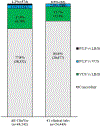Scaling resolution of variant classification differences in ClinVar between 41 clinical laboratories through an outlier approach
- PMID: 30311378
- PMCID: PMC6188667
- DOI: 10.1002/humu.23643
Scaling resolution of variant classification differences in ClinVar between 41 clinical laboratories through an outlier approach
Abstract
ClinVar provides open access to variant classifications shared from many clinical laboratories. Although most classifications are consistent across laboratories, classification differences exist. To facilitate resolution of classification differences on a large scale, clinical laboratories were encouraged to reassess outlier classifications of variants with medically significant differences (MSDs). Outliers were identified by first comparing ClinVar submissions from 41 clinical laboratories to detect variants with MSDs between the laboratories (650 variants). Next, MSDs were filtered for variants with ≥3 classifications (244 variants), of which 87.6% (213 variants) had a majority consensus in ClinVar, thus allowing for identification of outlier classifications in need of reassessment. Laboratories with outlier classifications were sent a custom report and encouraged to reassess variants. Results were returned for 204 (96%) variants, of which 62.3% (127) were resolved. Of those 127, 64.6% (82) were resolved due to reassessment prompted by this study and 35.4% (45) resolved by a previously completed reassessment. This study demonstrates a scalable approach to classification resolution and capitalizes on the value of data sharing within ClinVar. These activities will help the community move toward more consistent variant classifications, which will improve the care of patients with, or at risk for, genetic disorders.
Keywords: clinvar; data sharing; variant interpretation.
© 2018 Wiley Periodicals, Inc.
Conflict of interest statement
All authors are clinical service providers and are employed by laboratories that offer fee-based clinical sequencing. This employment is noted in the author affiliations. The authors declare no additional conflicts of interest beyond their employment affiliation.
Figures




References
-
- Balmaña J, Digiovanni L, Gaddam P, Walsh MF, Joseph V, Stadler ZK, … Domchek SM (2016). Conflicting Interpretation of Genetic Variants and Cancer Risk by Commercial Laboratories as Assessed by the Prospective Registry of Multiplex Testing. Journal of Clinical Oncology: Official Journal of the American Society of Clinical Oncology, 34(34), 4071–4078. 10.1200/JCO.2016.68.4316 - DOI - PMC - PubMed
-
- Butler RR, & Gejman PV (2018). Clinotator: analyzing ClinVar variation reports to prioritize reclassification efforts. F1000Research, 7, 462 https://doi.org/10.12688/f1000research.14470.2 - DOI - PMC - PubMed
-
- Dolinsky JS, Hruska KS, Pesaran T, Richardson ME, Klein RT, Solomon BD, & Gau C-L (2017). Efforts Toward Consensus Variant Interpretation by Commercial Laboratories. Journal of Clinical Oncology: Official Journal of the American Society of Clinical Oncology, 35(11), 1261–1262. 10.1200/JCO.2016.71.2505 - DOI - PubMed
-
- Furqan A, Arscott P, Girolami F, Cirino AL, Michels M, Day SM, … SHaRe Consortium. (2017). Care in Specialized Centers and Data Sharing Increase Agreement in Hypertrophic Cardiomyopathy Genetic Test Interpretation. Circulation. Cardiovascular Genetics, 10(5). 10.1161/CIRCGENETICS.116.001700 - DOI - PubMed
Publication types
MeSH terms
Grants and funding
LinkOut - more resources
Full Text Sources
Medical

